高考英语语法专题复习--代词
- 格式:doc
- 大小:53.00 KB
- 文档页数:7
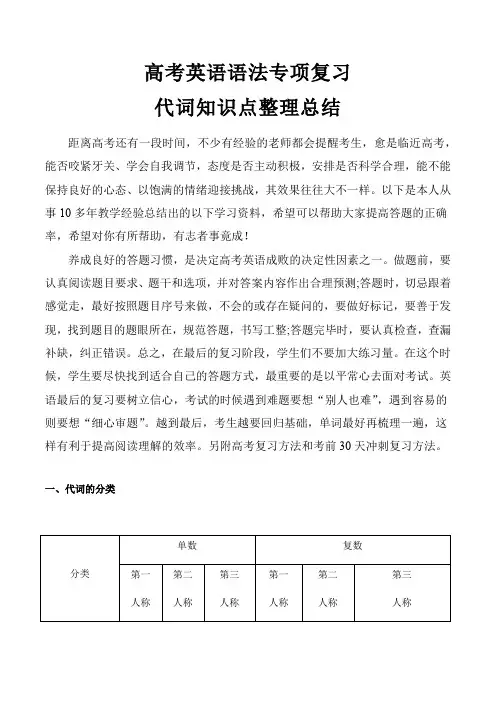
高考英语语法专项复习代词知识点整理总结距离高考还有一段时间,不少有经验的老师都会提醒考生,愈是临近高考,能否咬紧牙关、学会自我调节,态度是否主动积极,安排是否科学合理,能不能保持良好的心态、以饱满的情绪迎接挑战,其效果往往大不一样。
以下是本人从事10多年教学经验总结出的以下学习资料,希望可以帮助大家提高答题的正确率,希望对你有所帮助,有志者事竟成!养成良好的答题习惯,是决定高考英语成败的决定性因素之一。
做题前,要认真阅读题目要求、题干和选项,并对答案内容作出合理预测;答题时,切忌跟着感觉走,最好按照题目序号来做,不会的或存在疑问的,要做好标记,要善于发现,找到题目的题眼所在,规范答题,书写工整;答题完毕时,要认真检查,查漏补缺,纠正错误。
总之,在最后的复习阶段,学生们不要加大练习量。
在这个时候,学生要尽快找到适合自己的答题方式,最重要的是以平常心去面对考试。
英语最后的复习要树立信心,考试的时候遇到难题要想“别人也难”,遇到容易的则要想“细心审题”。
越到最后,考生越要回归基础,单词最好再梳理一遍,这样有利于提高阅读理解的效率。
另附高考复习方法和考前30天冲刺复习方法。
一、代词的分类二、代词的用法考点一it, that, one(s), those的用法1.it代替的是前面提到的同一事物,即同名同物,所代替的名词可以是可数名词,也可以是不可数名词。
如:I’d like to look at that atlas. May I borrow it?我想看看那张地图,我能借用一下吗(it代替可数名词atlas)?2.one叫作泛指代词代替的是前面提到的同名异物中的任何一个,所代替名词是可数名词单数,其前可带冠词与修饰语。
如果代替复数名词,则用ones。
如:①The population problem may be the greatest one in the world today.人口问题可能是当今世界上最大的一个问题。
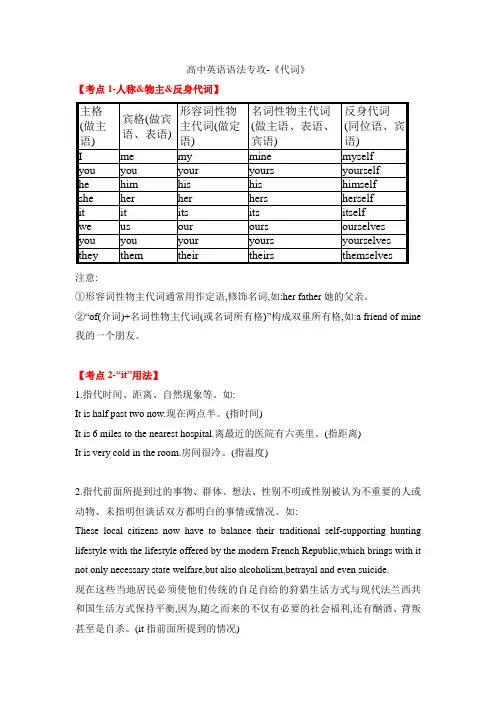
高中英语语法专攻-《代词》【考点1-人称&物主&反身代词】注意:①形容词性物主代词通常用作定语,修饰名词,如:her father她的父亲。
②“of(介词)+名词性物主代词(或名词所有格)”构成双重所有格,如:a friend of mine 我的一个朋友。
【考点2-“it”用法】1.指代时间、距离、自然现象等。
如:It is half past two now.现在两点半。
(指时间)It is 6 miles to the nearest hospital.离最近的医院有六英里。
(指距离)It is very cold in the room.房间很冷。
(指温度)2.指代前面所提到过的事物、群体、想法、性别不明或性别被认为不重要的人或动物、未指明但谈话双方都明白的事情或情况。
如:These local citizens now have to balance their traditional self-supporting hunting lifestyle with the lifestyle offered by the modern French Republic,which brings with it not only necessary state welfare,but also alcoholism,betrayal and even suicide.现在这些当地居民必须使他们传统的自足自给的狩猎生活方式与现代法兰西共和国生活方式保持平衡,因为,随之而来的不仅有必要的社会福利,还有酗酒、背叛甚至是自杀。
(it指前面所提到的情况)—Who’s that at the door?—It is the milkman.——门口那人是谁?——是送奶工。
(it指代性别不明或性别被认为不重要的人)—I’ve broken a plate.我打碎了一个盘子。
—It(=Breaking the plate) doesn’t matter.没关系。
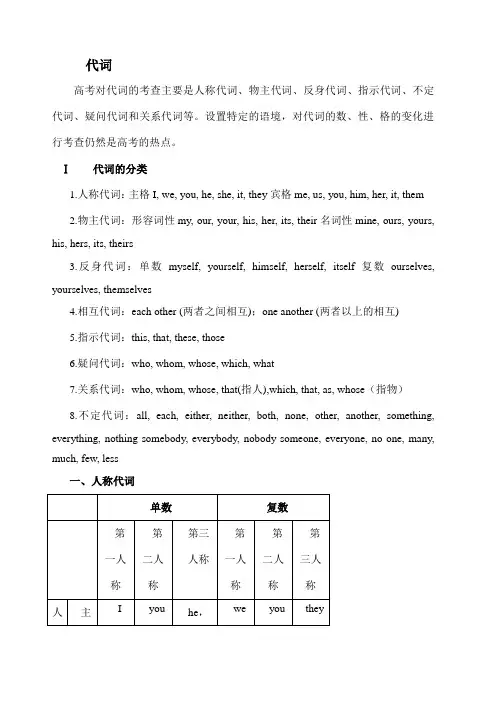
代词高考对代词的考查主要是人称代词、物主代词、反身代词、指示代词、不定代词、疑问代词和关系代词等。
设置特定的语境,对代词的数、性、格的变化进行考查仍然是高考的热点。
Ⅰ代词的分类1.人称代词:主格I, we, you, he, she, it, they宾格me, us, you, him, her, it, them2.物主代词:形容词性my, our, your, his, her, its, their名词性mine, ours, yours, his, hers, its, theirs3.反身代词:单数myself, yourself, himself, herself, itself复数ourselves, yourselves, themselves4.相互代词:each other (两者之间相互);one another (两者以上的相互)5.指示代词:this, that, these, those6.疑问代词:who, whom, whose, which, what7.关系代词:who, whom, whose, that(指人),which, that, as, whose (指物)8.不定代词:all, each, either, neither, both, none, other, another, something, everything, nothing somebody, everybody, nobody someone, everyone, no one, many, much, few, less一、人称代词单数复数第一人称第二人称第三人称第一人称第二人称第三人称人主I you he,we you they称代词格she,it宾格me you him,her,itus you them人称代词的用法1.人称代词的主格在句子中作主语或主语补足语。
如:John waited a while but eventually he went home.约翰等了一会儿,最后他回家了。
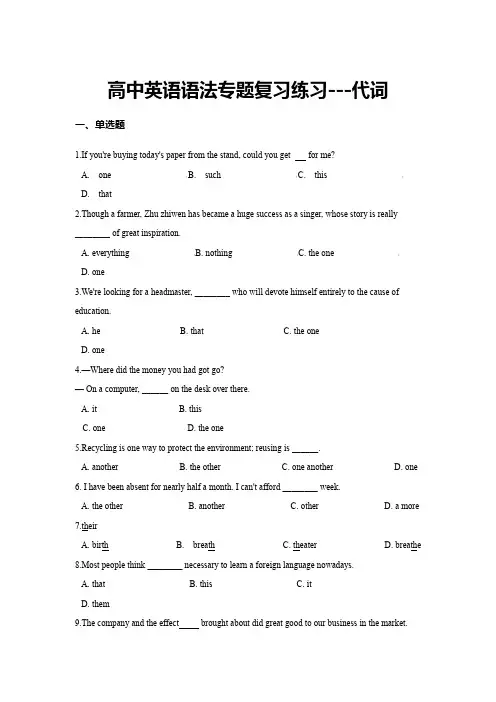
高中英语语法专题复习练习---代词一、单选题1.If you're buying today's paper from the stand, could you get for me?A. oneB. suchC. thisD. that2.Though a farmer, Zhu zhiwen has became a huge success as a singer, whose story is really________ of great inspiration.A. everythingB. nothingC. the oneD. one3.We're looking for a headmaster, ________ who will devote himself entirely to the cause of education.A. heB. thatC. the oneD. one4.—Where did the money you had got go?— On a computer, ______ on the desk over there.A. itB. thisC. oneD. the one5.Recycling is one way to protect the environment; reusing is ______.A. anotherB. the otherC. one anotherD. one6. I have been absent for nearly half a month. I can't afford ________ week.A. the otherB. anotherC. otherD. a more7.theirA. birthB. breathC. theaterD. breathe8.Most people think ________ necessary to learn a foreign language nowadays.A. thatB. thisC. itD. them9.The company and the effect brought about did great good to our business in the market.A. itB. whichC. thatD. what10.The doctor thought ________ would be good for you to have a holiday.A. thisB. itC. oneD. That11.—Which driver was to blame?— Why, ______! It was the child's fault, clear and simple. He suddenly came out between two parked cars.A. bothB. eachC. eitherD. neither12.By the way, who will teach ___ pop music next term?A. usB. OurC. oursD. we13.In my opinion, there's no greater happiness than of succeeding in one's career.A. oneB. itC. thatD. those14.—Mum, could I have an apple? I am a bit hungry.—Didn't you just have .A. itB. thatC. oneD. this15.He found ________ almost impossible to express what he wanted to say.A. thatB. thisC. itD. one16.Some students take ________ for granted that they can learn English well so long as they do many exercises.A. thisB. thatC. itD. them17.We bought ______ a present, but _______ didn't like it.A. they, themB. them, theyC. themselves, theirD. theirs, they18.The information on the Internet gets around much more rapidly than in the newspaper.A. itB. thoseC. oneD. that19.Health reports believe that even a little exercise is rather better than ___ at all.A. no oneB. noneC. nothingD. anything20.Houses in China's big cities are so unreasonably expensive that generally young couples can't afford _______ without their parents' financial support.A. thatB. itC. anyD. one21.—Who's that at the door?—is the milkman.A. HeB. ItC. ThisD. That22.The population of China is larger than ________ of the United States.A. thisB. thatC. theseD. those23.We have many summer camps for your holidays. You can choose ____ based on your own interest.A. themB. eachC. oneD. it24.The population of China is larger than of Japan.A. theseB. thatC. thisD. those25.He invited the three of ___, Bob, Tom and ___.A. we...me B. us (I)C. we…ID. us…me26.I got them a grand piano because they like when I come home and play for them.A. oneB. itC. thisD. that27.Mr Brown gave me a very valuable present, ________that I have never seen.A. the oneB. itC. oneD. which28._______ will do good to patients to follow the advice of doctors, because they're professional.A. TheyB. ItC. AsD. That29.I wanted to give you some bread, but was left.A. neitherB. nothingC. noneD. no one30.That's an unpleasant thing to say about your father after ________ he's done for you.A. somethingB. anythingC. allD. that31.Mr. Smith gave the tickets to all the students except _______ who had already seen the movie.A. the onesB. onesC. othersD. the others32.My daughter thought she was________ when I asked him for the advice on the new plan.A. somethingB. anythingC. somebodyD. anybody33.—Is this your book?—No. It's not . It's .A. my; hisB. mine; hersC. me; him34.They are learning to act graciously when success comes ________ way.A. itsB. hisC. herD. their35.It is important to make new laws and create international standards for these laws similar to_______ concerning international airspace.A. whatB. thatC. thoseD. it36.Mom promised to buy me a nice gift for my birthday, ________ beyond my imagination.A. the oneB. thatC. whichD. something37.I'd appreciate ______ if you would like to teach me how to use the computer.A. thatB. itC. thisD. you38.______ road out of town is good, but this one is better than the other.A. BothB. AllC. NoneD. Neither39.— What do you think about that new librarian?— She is ______of a good clerk, for she even doesn't know how to classify the books.A. somebodyB. nothingC. somethingD. nobody40.Of those who are married,in more than 80 percent of cases,the wives' education background is equal or higher than of their husbands.A. itB. oneC. thatD. the one二、语法填空41.So difficult did he find________ to pass the driving test that he decided to quit.42.Hobbies provide interests that keep bedridden patients from thinking about ________ (them).43.You will find ________quite helpful to do what you are interested in.44.—Silly me! I forgot what my bag looks like.—What do you think of ________ over there?45.Every rock looked like a person or animal, every steam that joined the great river carried________ (it) legends, every hill was heavy with the past.答案一、单选题1.【答案】A【解析】【分析】句意:如果你去报摊上买今天的报纸,给我捎回一份好吗?one作“一个”,“一本”,“一件”等解,用来代替上文提到过的paper。
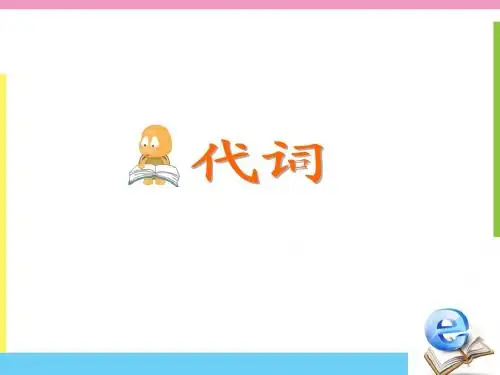

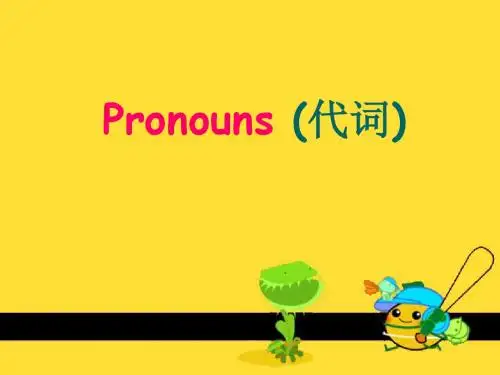

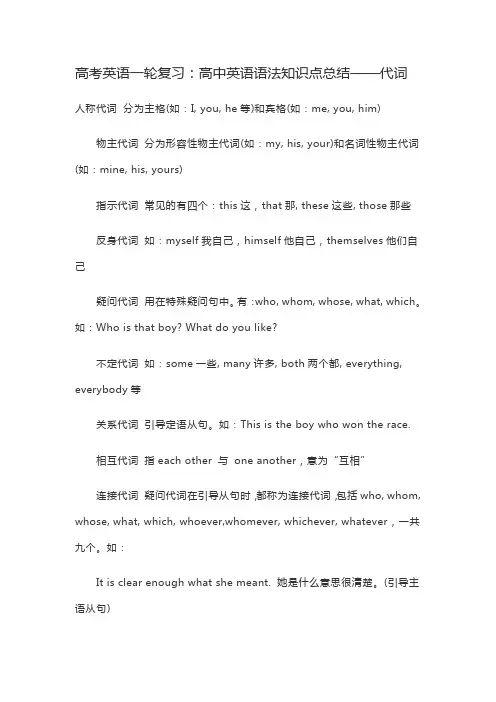
高考英语一轮复习:高中英语语法知识点总结——代词人称代词分为主格(如:I, you, he等)和宾格(如:me, you, him) 物主代词分为形容性物主代词(如:my, his, your)和名词性物主代词(如:mine, his, yours)指示代词常见的有四个:this这,that那, these这些, those那些反身代词如:myself我自己,himself他自己,themselves他们自己疑问代词用在特殊疑问句中。
有:who, whom, whose, what, which。
如:Who is that boy? What do you like?不定代词如:some一些, many许多, both两个都, everything, everybody等关系代词引导定语从句。
如:This is the boy who won the race.相互代词指each other 与one another,意为“互相”连接代词疑问代词在引导从句时,都称为连接代词,包括who, whom, whose, what, which, whoever,whomever, whichever, whatever,一共九个。
如:It is clear enough what she meant. 她是什么意思很清楚。
(引导主语从句)I don’t care what they think. 他们怎么想我不管。
(引导宾语从句)第1讲人称代词第2讲指示代词人称代词分为主格和宾格。
考点1. 代词作同位语如果代词和名词指代相同时,常用主格或宾格作同位语,不用物主代词。
改错:Our Chinese people are friendly.把our改为we, 因为我们本身就是中国人。
考点2. 用人称代词宾格代替主格的情况①口语中作表语的人称代词一般用宾格,不用主格。
—Who is it? —It’s me.②在比较句型中,as和than后的主格可以用宾格代替。
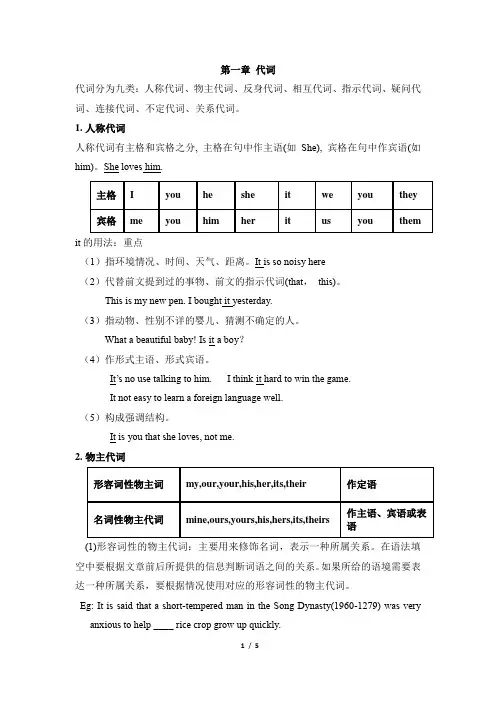
第一章 代词代词分为九类:人称代词、物主代词、反身代词、相互代词、指示代词、疑问代词、连接代词、不定代词、关系代词。
1. 人称代词人称代词有主格和宾格之分, 主格在句中作主语(如She), 宾格在句中作宾语(如him)。
She loves him.it 的用法:重点(1)指环境情况、时间、天气、距离。
It is so noisy here(2)代替前文提到过的事物、前文的指示代词(that , this)。
This is my new pen. I bought it yesterday.(3)指动物、性别不详的婴儿、猜测不确定的人。
What a beautiful baby! Is it a boy ?(4)作形式主语、形式宾语。
It’s no use talking to him. I think it hard to win the game.It not easy to learn a foreign language well.(5)构成强调结构。
It is you that she loves, not me.2. 物主代词 形容词性物主词 my,our,your,his,her,its,their 作定语名词性物主代词 mine,ours,yours,his,hers,its,theirs作主语、宾语或表语 (1)形容词性的物主代词:主要用来修饰名词,表示一种所属关系。
在语法填空中要根据文章前后所提供的信息判断词语之间的关系。
如果所给的语境需要表达一种所属关系,要根据情况使用对应的形容词性的物主代词。
Eg: It is said that a shorttempered man in the Song Dynasty(1960-1279) was very anxious to help ____ rice crop grow up quickly. 主格I you he she it we you they 宾格 me you him her it us you them(2)名词性的物主代词:名词性的物主代词多数会在句子中充当表语或者宾语。
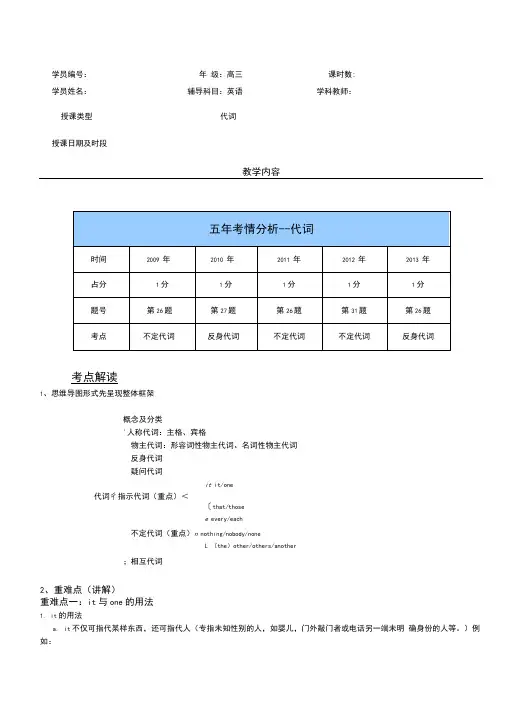
学员编号:年级:高三课时数:学员姓名:辅导科目:英语学科教师:授课类型代词授课日期及时段教学内容考点解读1、思维导图形式先呈现整体框架概念及分类'人称代词:主格、宾格物主代词:形容词性物主代词、名词性物主代词反身代词疑问代词it it/one代词彳指示代词(重点)<〔that/thosee every/each不定代词(重点)n nothing/nobody/noneL (the)other/others/another;相互代词2、重难点(讲解)重难点一:it与one的用法1.it的用法a.it不仅可指代某样东西,还可指代人(专指未知性别的人,如婴儿,门外敲门者或电话另一端未明确身份的人等。
)例如:Is it a boy or a girl? It's a girl.Someone is ringing the doorbell. Go and see who it is.b.it可指代时间、季节、地点、天气、距离、金钱等。
例如:I hope it is spring all the year round.It is no far from the school to my home.c.it用作形式主语或形式宾语。
例如:It is certain that food prices are going up.She soon found it possible to go to the fitness club regularly.2.one的用法one是不定代词,可代替前面出现的某个可数名词,复数为ones。
例如:I would like to have a digital camera, but I can 't afford one.There are only hard chocolates left; we ve eaten all the soft ones.重难点二:that与those的用法that替代被限定的、有定语修饰的名词;that可替代可数名词单数或不可数名词,指代可数名词复数时用those。
高考英语语法专项――代词练习1. —Which of the two computer games did you prefer? —Actually I didn’t like ______.A. both of themB. either of themC. none of themD. neither of them2. The English spoken in the United States is only slightly different from ______ spoken in England.A. whichB. whatC. thatD. the one3. The two girls are getting on very well and share _______ with each other.A. littleB. muchC. some D none4. –How do you find your new classmates?– Most of them are kind, but ____ is so good to me as Bruce.A. noneB. no oneC. every oneD. some one5. Our nerghbors gave ____ a baby bird yesterday that hurt ______ when it fell from its nest.A. us,itB. us,itselfC. ourselves, itselfD. ourselves, it6. Make sure you’ve got the passports and tickets and ______ before you leave.A. somethingB. anythingC. everythingD. nothing7. Isn’t it amazing how the human body heals ____ after an injury?A. himselfB. himC. itselfD. it8. —Could you tell me how to get to Victoria Street?—Victoria Street? ______ is where the Grand Theatre is.A. SuchB. ThereC. ThatD. This--just an old desk.9. He doesn’t have _________ furniture in his roomA. anyB. manyC. someD. much10. The manager believes prices will not rise by more than _____ four percent.A. any otherB. the otherC. anotherD. other–Sorry, there’s ______ left.11.–I’d like some more cheese.A. someB. noneC. a littleD. few12. It was hard for him to learn English in a family, in which _____ of the parents spoke the language.A. noneB. neitherC. bothD. each13. To know more about the British Museum, you can use the Internet to go to the library, or _______.A. neitherB. someC. allD. both---Sorry, let’s make it __ time.14.—Could we see each other at 3 o’clock this afternoon?A. other’sB. the otherC. anotherD. other15. -- Do you want tea or coffee? -- ______, I really don't mind.A. noneB. neitherC. eitherD. all16. The old peasant said that he preferred a street in a small town to ___ in such a large city as Shanghai.A. itB. thisC. thatD. one17.______ is known to everybody, Taiwan is a part of China. We must unify it.A.It B.As C.That D.What18. ______ is known to us all is that China has launched Shenzhou V spaceship successfully.A. ThatB. WhatC. ItD. As19. It's impossible for all the people to get jobs because of them are not fit for them.A. noneB. allC. not allD. every one20. For quite _____ students,their teacher's advice is more important than _____ of their parents'.A. few;oneB. a few;thatC. a little;someD. a lot;many21. I will never know what was on his mind at the time, nor will________.A. anyoneB. anyone elseC. no oneD. no one else22. ________ is often the case, we have worked out the production plan.A. WhichB. WhenC. WhatD. As?23.I have done most of the housework. Would you please finish ___________A. the otherB. the othersC. the restD. another24. Clothing made of man-made fibres has certain advantages overmade of naturalfibres like cotton ,wool or silk.A. the onesB. oneC. thatD. what25. People think that the beauty of the mountains is great than _____ of the desert.A. oneB. the oneC. thoseD. that26. Would you please make a copy for everybody in the office and _____ extra ones for the visitors?A. otherB. manyC. fewD. some——Yes. Even I myself didn’t believe I could make_____.27. ——Did you reach the top of the mountain?A. thatB. itC. myselfD. them28.--- Is the television advertisement working ? ---Yes, ______ orders are coming.A. NoneB. SomeC. MoreD. Fewer29. _____ is announced in today’s paper, China has succeeded in launching the second manned spacecShenzhou 6. A. It B. That C. What D. As30.___is reported in the newspaper is that seventeen climbers have been killed in the snow tsunami.A. ItB. AsC. WhatD. That31. ---- I haven’t found any money though I’ve searched the drawer bottom up..---- Then, I’m afraid there is ______ leftA. nothingB. no oneC. noneD. neither32. ---------H aven’t they apologized to you yet?----No explanation was offered, ___________an apology.A. still lessB. neitherC. notD. or rather33. -----------Is the television advertisement working ?---------No, __________ orders are coming.A. NoneB. SomeC. MoreD. Few34. Fish have eyes and ________appears to be a nose, and they can hear, too.A. thatB. whichC. itD. whatound any black ink .35. —I’ve looked everywhere , but I haven’t f—Then , I’m afraid there is left .A. nothingB. no oneC. noneD. neither36. The exercise is not difficult but just needs care and patience.A. by itselfB. of itselfC. in itselfD. for itself37.—When can we come to visit you?—Anytime you feel like .A. oneB. it C .so D. that38. ---- Do you think _____ seems to be any need for us to get there? ---- Yes, I think so.A. itB. thisC. whatD. there39. -- How long are you staying there? --- ______ depends.A. ItB. AnythingC. ThisD. Everything40. I had to buy ______of these books because I didn’t know which one was the best.A. bothB. noneC. neitherD. whole41. ----- Can I help you?----- I’d like to buy a present for my father’s birthday, ____ at a proper price, but of great value.A. whichB. thatC. oneD. any one42. -- Did you have any trouble with the customs? -- to speak of.A. NoneB. NeitherC. NothingD. No43. I haven’t seen of her films, but judging from the one I have seen recently I think sheactress. A. both B. any C. either D. none44. A scientist who speaks and writes English is in closer touch with the scientists i n other countries t hanwho doesn’t. A. one B. those C. / D. that45. —Mum, may I have to eat? I ’m so hungry.—Yes, there is lots of bread in the fridge, Help yourself.A. enoughB. muchC. anythingD. something46.The expert thought the coins the farmer had found under the ground were just copper ________ gold.A.other thanB.rather thanC.more thanD.in place of47.Within industries,companies are always trying to develop products that are one step better than ________of other companies. A.one B.that C.those D.it248.—Why was the Chinese actress Gong Li chosen as the leading actress in the film Curse on the GoldenFlowers?—Because the part of the queen required intelligence and beauty, ________ she has.A.both of whomB.both of whichC.all of whichD.every one of them49. Have you seen the film Lust, Caution, _______directed by Ang LeeA. itB. thatC. whichD.the one50.Wise teachers know it’s impossible for all the students to learn all the subjects well because ______ of them are not fit for them. A.everyone B.all C.none D.not allup in time of difficulty.51.I’m in search of a man to do the job, ______ always trying his best and never giving A.that B.the one C.one D.such52. The couple often eats out because _______ of them can cook .A. bothB. allC. neitherD. none53.—Which of the two books will you buy? —I will buy , for I’ve got some suchbooks.A.both B.either C.neither D.no one54. So difficult did I find ____ to work out the problem that I decided to ask my partner for help.A. myselfB. usC. itD. that55.After seemed like hours he came out with a bitter smile.A.which B.it C.what D.that56. —Have you heard of this new brand of computer, Mike?—Yes, of course, and I’ve decided to buy ___.A. itB. oneC. thisD. that57. I thought things would get better, but , ______, they are getting worse.A. as they areB. as it isC. as it wasD. as they were58 .---Has anything new been discussed on that problem so far? --- _______, and more will follow, I think.A. LittleB. FewC. MuchD. All59. --- How do you like this man?---He is _______ of a good businessman, for his business is always in a mess.A. somebodyB. nobodyC. somethingD. nothing60.Are there any books on animal cloning ? If so ,I want to borrow .A.them B.one C.it D.that61.______ and we will complete the task sent to us.A. Another hourB. An hour laterC. After an hourD. In an hour62.is often the case ,my mother has the final say in the argument.A.It B.That C.What D.As63.Understanding the culture habits of another nation, especially_____ containing as many differentsubcultures as the United States, is a difficult task.A. oneB. itC. thatD. the one64. Though he was always finding excuses of one sort or _____ for his being absent from work, none of uswould believe him. A. the other B. others C. another D. other℃ higher than in 65.From the chart we can Iearn that the highest temperature in Auckland is nearly 3 Wellington.A. it B. that C. this D. one1---10BCBAB CCCAC 11---20BBDCC DBBBB 21---30BDCCD DBCDC 31---40CCADC CBDAB 41---50CAAAD CBBDB 51---60CCCCC BBCDB 61---65ADACB。
考点知识全面总结高频考点知识总结一人称代词、物主代词、反身代词和疑问代词(一)人称代词1.当说话者不清楚或不必要知道说话对象的性别时,可以用it来表示。
如:It’s a lovely baby. Is it a boy or a girl?这孩子真可爱。
是男孩还是女孩?2. 人称代词有时也可用作名词。
如:It’s not a she; it’s a he.那不是女孩是个男孩。
3. 人称代词单独使用时,一般不用主格而用宾格。
如:---Glad to meet you. 见到你我很高兴。
---Me, too. 我也是。
4. 代词they(不分性别)代表一提到过的一些人或物,在口语中还可以代替he or she。
此外,they还可泛指一般人。
如:The Browns phoned. They’re coming round this evening.布朗夫妇打电话了。
他们今天晚上到。
If anyone arrives late, they’ll have to wait outside.谁要是迟到,谁就得在外面等着。
(代替he or she)They say we’re going to have a hot summer.据说今年夏天将会很热。
(泛指一般人)(二)物主代词物主代词即人称代词的所有个形式,它可分为形容词性物主代词(my, your, his, her, its, our, theirs)和名词性物主代词(mine, yours, his, hers, its, ours, theirs)1.形容词性物主代词相当于形容词,只能作名词或动名词的定语。
如:This is our classroom. 这是我们的教室。
(作名词的定语)Would you mind my opening the window? 你介意我开窗户吗?(作动名词的定语或被称为动名词的逻辑主语)2.名词性物主代词相当于“形容词性物主代词+名词”,可单独做主语、宾语、表语;此外,名词性物主代词还可与名词及of连用,构成双重所有格,即:a/ an/ this/ these/ those/ some/ any/ several/ no/ each/ every/ such/ another/ which+名词+of+名词性物主代词。
高考英语复习语法知识专题讲解专题三代词一、代词的分类用来代替名词或起名词作用的词、短语、分句或句子的词叫作代词。
英语中的代词可分为类人称代词主格 I we you you he,;she; it they 宾格me us you you him;her;it them物主代词形容词性my our your your his;her;its their 名词性mine ours yours yours his;hers;its theirs 反身代词myself ourselves yourself yourselves himself;herself;itself themselves 指示代词this, that, these, those, such, so不定代词 one, some, any, each, none, all, both, neither, either, other, another, no, many,much, (a)few,(a)little, something, anything, nothing, everything相互代词 each other, one another疑问代词who, whom, whose, which, what ,whoever, whichever, whatever连接代词who, whom, whose, which, what,whoever, whichever, whatever关系代词that, which, who, whom, whose, as二、常考代词的用法1.both, all, either, any, neither, none 微专题易错点指代范围代词用法两者both 意为“两者都”,是对两者的肯定either 意为“(两者中)任一个”,表示二选一neither 意为“都不”,是对两者的否定all 意为“全部”,指代或修饰可数名词复数或不可数名词三者或三者以上any 意为“任何一个”,指代或修饰可数名词单数或不可数名词none意为“全无,没有一点”,指代可数名词复数或不可数名词指物或人,其后可接表示范围的of...回答 how many/how much 的提问no one意为“没有人”,只指人其后不接表示范围的of...回答 who 的提问例:He is good at both English and French.You can take either of the pictures, whichever you like.It was a game in which neither team would win.Neither of us could understand German.All are happy to know the news.Phone me any day next week.We had three cats once but none(of them)is alive now.No one knows the answer.-How many of you have been to the Great Wall?-None.2.other, another 微专题易错点两者都意为“另一个”。
最新高考英语语法专题复习代词最新高考英语语法专题复习--代词高考英语语法专题复习三、代词知识要点:代词是代替名词、名词短语或句子的词。
代词可分为人称代词、物主代词、指示代词、反身代词、不定代词、疑问代词、相互代词、连接代词、关系代词等九类。
一、人称代词人称代词在句中可以用作主语(用主格,如i,you,he,she,it,we,they,等)和宾语(用宾格,如me,you,him,her,it,us,them等):人称代词的用法:注意:(1)在电话上或是/是/是谁。
当句型的重音部分是主语时,使用主格:---isthatmr.li?---yes.thisishe.it’siwhodidit.这是我干的。
(2)单独使用的人称代词通常用宾格:“我累了。
”“我。
”“我累了。
”“我也累了。
”“谁想要这个?”“我。
”“谁想要这个?”“我想。
”(3)有时,主格或宾格的使用会导致意义的变化:ilikeyoubetterthanhe.我比他更喜欢你。
为ilikeyoubetterthanhelikesyou.ilikeyoubetterthanhim.我喜欢你胜过喜欢他。
为ilikeyoubetterthanilikehim.(4)人称代词的排列顺序:单数人称代词通常按“二三一”排列,即you,heandi;复数人称代词通常按“一二三”排列,即we,youandthey:you,heandiareofthesameage.你,他和我都是同一年龄。
我们,你们和他们都是好公民。
我们、你们和他们都是好公民。
但是,如果在诸如责任或错误等情况下使用,第一人称I可以放在其他人称代词之前:tomandihopetogothere.汤姆和我想去那儿。
iandtomaretoblame.我和汤姆该受批评。
但是,youandi是固定结构,语序通常不宜颠倒。
(5)人称代词后面跟着名词同位语。
有些人称代词后面有时可以跟同位语:人是给我们学生的,这些小桌子是给我们学生的。
高考英语语法专题复习三、代词知识要点:代词是代替名词、名词短语或句子的词。
代词可分为人称代词、物主代词、指示代词、反身代词、不定代词、疑问代词、相互代词、连接代词、关系代词等九类。
一、人称代词人称代词在句中可以用作主语(用主格,如I, you, he, she, it, we, they, 等)和宾语(用宾格,如me, you, him, her, it, us, them等):人称代词的用法:注:(1)在电话中或It is/was...that/who...强调句型中被强调部分做主语时,用主格:---Is that Mr. Li? ---Yes. This is he. It’s I who did it. 这是我干的。
(2)单独使用的人称代词通常用宾格:“I’m tired.” “Me too.” “我累了。
”“我也累了。
”“Who wants this?” “Me.” “谁要这个?”“我要。
”(3)有时用主格或宾格会导致意思的变化:I like you better than he. 我比他更喜欢你。
为I like you better than he likes you.I like you better than him. 我喜欢你胜过喜欢他。
为I like you better than I like him.(4)人称代词的排列顺序:单数人称代词通常按“二三一”排列,即you, he and I;复数人称代词通常按“一二三”排列,即 we, you and they:You, he and I are of the same age. 你,他和我都是同一年龄。
We , you and they are all good citizens. 我们,你们和他们都是好公民。
但若用于承担责任或错误等场合,则可把第一人称 I 置于其他人称代词之前:Tom and I hope to go there. 汤姆和我想去那儿。
I and Tom are to blame. 我和汤姆该受批评。
但是,you and I 是固定结构,语序通常不宜颠倒。
(5)人称代词后跟名词同位语。
有些人称代词后有时可跟同位语:These small desks are for us students. 这些小课桌是给我们学生的。
We girls often go to the movies together. 我们女孩子常一起去看电影。
He asked you boys to be quiet. 他要你们男孩子安静些。
二、物主代词物主代词分形容词性物主代词(my, your, his, her, its, our, your, their)和名词性物主代词(mine, yours, his, hers, its, ours, yours, theirs)。
形容词性物主代词相当于形容词,置于名词前,作定语;名词性物主代词相当于“形容词性物主代词+名词”,在句中作主语、宾语、表语、连用of作定语:His son is taller than hers. 他的儿子比她的儿子高。
Ours is a great country. 我们的国家是一个伟大的国家Her son is a friend of ours. 她的儿子是我们的朋友。
This is your pen. Mine is in the box. 这是你的铅笔,我的在铅笔盒里。
注:(1) a friend of mine (ours, yours, hers, his, theirs)结构(2) 物主代词与own 连用。
表强调。
也可用of one’s own置于名词后作定语:Mind your own business. 别管闲事。
I saw it with my own eyes. 那是我亲眼看到的。
I hope to have a room of my own. / I hope to have my own house. 我希望有自己的房子。
三、指示代词指示代词是用来指代或标记人或事物的代词,表示“这个,这些”“那个,那些”。
在句中可作主语、宾语、表语、定语;(单数:this, that;复数:these, those;为了方便学习将such,so也归于此类)。
I like these and he likes those. 我喜欢这些,他喜欢那些。
What I want to say is this. 我想说的就是这点。
注:(1) 指示代词用作主语和定语时,可指人或物;用作宾语和表语时,只指物。
如:This is my father. (作主语,指人) Do you know this? (作宾语,指物,译为“你知道这个情况吗?)(2) 刚提到的或已经完成的事情时用 that,但是若要指下文将要发生或将要提到的事情通常用 this:She married Jim, and that surprised me. 她嫁给了吉姆,这使我感到很吃惊。
I want to know this: Is he healthy? 我想知道这一点:他是否很健康。
(3) 在打电话时,通常用 this 指自己,用 that 指对方:Hello. This is Jim. Is that John? 喂,我是吉姆,你是约翰吗?(4) such指代前面所述的这样的人或事。
如:Such is Albert Einstein, a famous physicist, but a simple man. 这就是艾尔伯特,爱因斯坦,......(5) so代替一个句子或短语表达的事情。
a.在believe,expect,suppose,imagine,think等词后用so代替前文观点。
表肯定、否定(=not)均可。
b. 用于表示肯定的hope,I’m afraid后,代替前文提出的观点。
四、反身代词反身代词是 oneself根据所指词的人称、性别、单复数等变化的词(单数: myself, yourself,himself, herself, itself, 复数:ourselves, yourselves, themselves ),在句中可作宾语、表语、同位语,不能作主语。
注:(1)用作同位语(加强被修饰词的语气,紧放在被修饰名词后, 或句末):The box itself is not so heavy. 箱子本身并不重。
You yourself said so. / You said so yourself. 你自己是这样说的。
(2)用作宾语(动词或for,of, in, by, to等介词的宾语):She could not make herself understood. 她不能使别人听懂她的话。
You’ll have to see if he has come for yourself. (for one self 亲自,为自己)The computer may shut off of itself. (of oneself 自动的)You shouldn’t leave the child at home by herself. (by one self 独自,单独)Jim isn’t bad in himself, but he likes playing tricks on others. (in one self 本身)He likes a table to himself. (to oneself 独自占用)(3) 用作表语:有时用于 be, feel, seem, look 等后作表语表示身体或精神处于正常状态:The poor boy was myself. 那个可怜的孩子就是我自己。
The ones who really want it are ourselves. 真正想要它的是我们自己。
I'm not quite myself these days. 我近来身体不大舒服。
I'll be myself again in no time. 我过一会儿就会好的。
(4) 含有反身代词的动词短语:devote oneself to=be devoted to 专心于;lose oneself=be lost in 迷失;seat oneself= be seated 坐下; express oneself 表达某人的思想; say for oneself 为自己找借口;say to oneself 心想; talkto oneself 自言自语; feel oneself 觉得正常; come to oneself 苏醒;五、疑问代词疑问代词包括who, whom, whose,which, what,在句中可用作主语、表语、宾语、定语等:1、who 与 whom的用法:前者为主格,用作主语、宾语,后者为宾格,用作宾语。
Who spoke at the meeting? Whom are you talking about?口语中或作宾语的 whom 位于句首时,通常可用who 代替,但whom前有介词时除外:Who(m) is the letter from?2、whose的用法:表示“谁的”,既可用于名词前作定语,也可单独使用。
在句中作主、宾、表、定语。
Whose is better, yours or hers?(作主语) Whose do you love better, yours or hers?(作宾语)Tom has already taken his bag away.Whose is this?(作表语) Whose bag do you like?(作定语)3、what和 which 的用法:有选择范围时,多用 which;无选择范围或不明确时,多用 what。
拓展:what的习惯用法:(1) What...for...? 和What for? 用于询问原因和目的。
---What did you put it into the soup for? --- It would improve the taste.(你为什么...?)---I’m going to the grocery store. ---What for? We still have enough food in the apartment.(为何啊?)(2)What if...?表示假设、建议、征求意见或疑虑。
What if it rains while we are on the way?(3)What do you mean (by...)?表示愤怒、不满等情绪。